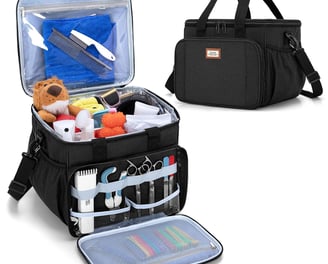How To Spot Tapeworms in Cats – Expert Advice
Learn how to spot tapeworms in cats, the symptoms, treatment options like cat tapeworms medicine, and prevention tips. Experts advise for every cat owner!
CATS


Introduction
Cats are curious creatures, often getting into spaces that you’d never imagine. Unfortunately, this curiosity sometimes exposes them to unwanted parasites, including tapeworms. Tapeworm infestations can affect your feline friend’s health and quality of life, but the good news is they can be spotted and treated effectively.
This article provides expert advice on how to spot tapeworms in cats, outlining the signs, symptoms, diagnosis, treatment options, and preventative measures. By the end of this guide, you'll feel equipped to safeguard your cat’s health and well-being.
Upgrade your pet grooming game – Grab the CURMIO Tote Bag now on Amazon!
Understanding Tapeworms in Cats
What Are Tapeworms?
Tapeworms are flat, segmented intestinal parasites that attach themselves to a cat’s small intestine. They feed off partially digested food and can grow several inches long. The most common tapeworms in cats include:
Dipylidium caninum: Transmitted through fleas.
Taenia taeniaeformis: Acquired through consuming infected rodents or small animals.
How Are Cats Typically Infected?
Cats become infected by accidentally ingesting tapeworm larvae, often through:
Grooming themselves after coming into contact with fleas carrying tapeworm eggs.
Eating prey carrying the parasite, such as rodents or infected birds.
Recognizing how tapeworms are transmitted is the first step in protecting your furry friend.
Signs and Symptoms of Tapeworms in Cats
Spotting tapeworms takes a watchful eye and understanding of the symptoms. While tapeworm infestations are not always immediately apparent, here are key signs to look for:
Observable Signs:
Segments in Stool or Fur: Tapeworm segments resemble grains of rice and may be visible in your cat's feces or stuck to the fur around their anus.
Scooting Behavior: Your cat may drag their bottom along the floor in an effort to alleviate irritation caused by tapeworm segments.
Vomiting or Diarrhea: Digestive upset can occur in cases of significant infestations.
Changes in Appetite: Some cats become hungry more frequently, while others lose their appetite.
Weight Loss: A tapeworm's nutrient consumption can cause unexplained weight loss in your cat.
Lethargy: A lack of energy may signal an underlying health issue, including tapeworms.
Symptoms can vary based on the type of tapeworm and severity of infestation. If any of these symptoms sound familiar, it’s time to take action.
Diagnosing Tapeworms in Cats
Methods Used by Veterinarians:
Diagnosing tapeworms requires professional assistance. Veterinarians typically:
Perform a Fecal Examination: Tapeworm eggs or segments can often be identified under a microscope.
Physical Checkup: A vet may identify other telltale signs, like dried segments on your cat's fur.
Consider Your Cat’s History: Discussing your cat’s lifestyle, including exposure to fleas or rodents, helps pinpoint the parasite’s source.
Early diagnosis is essential to avoid prolonged infestations and reduce risks to your cat’s health.
Upgrade your pet grooming game – Grab the CURMIO Tote Bag now on Amazon!
Treating and Preventing Tapeworms in Cats
Treatment Options
If your cat is diagnosed with tapeworms, treatment is straightforward. Options include:
Cat Tapeworm Medicine: Prescription dewormers such as praziquantel are highly effective and safe. These may be administered as oral tablets, topical solutions, or injections.
How to Treat Tapeworms in Cats Naturally: While natural remedies (e.g., pumpkin seeds or food-grade diatomaceous earth) are occasionally discussed, they should only supplement veterinarian-prescribed treatment. Always consult your vet before trying these methods.
Antiparasitics for Flea Control: Treating the fleas that caused the infestation is a key step to ensure long-term relief.
Prevention Tips
An ounce of prevention is worth a pound of cure! Keep tapeworms at bay by:
Maintaining Proper Flea Control: Use veterinarian-recommended flea prevention treatments year-round.
Monitoring Outdoor Activity: Limit access to areas where your cat may encounter infected prey.
Regular Grooming and Hygiene: Brush your cat frequently and clean their bedding to minimize exposure to fleas.
Routine Deworming: For outdoor cats or those at higher risk, regular deworming helps protect against re-infestation.
Dr. Sarah, Parasitologist at Fuzzy Friends Animal Hospital, emphasizes, “Preventing flea infestations in cats is one of the key steps in reducing the risk of tapeworms. Maintaining a flea control program recommended by your veterinarian is important for overall parasite prevention.”
When to See a Vet About Tapeworms in Cats
It’s always better to be proactive than reactive. If you notice any symptoms of tapeworm infestation, contact your vet immediately. Additionally:
Schedule regular check-ups to ensure your cat's overall health.
Be extra vigilant if your cat frequently goes outdoors or interacts with other animals.
Dr. Jane, a veterinarian at Paws and Claws Veterinary Clinic, notes, “Early detection of tapeworms is crucial for the well-being of cats. Regular check-ups and vigilance from pet owners play a significant role in preventing severe infestations.”
Real-Life Cases That Show the Value of Vigilance
Mittens: This 3-year-old domestic shorthair suffered weight loss and increased appetite until a fecal examination revealed tapeworm eggs. A swift treatment plan not only resolved the infestation but restored Mittens to full health.
Oscar: During a routine check-up, tapeworm segments were spotted in Oscar’s feces despite no observable symptoms. Early detection prevented further health problems and educated his owner on preventative measures.
These cases underscore the importance of regular veterinary visits.
Keeping Your Cat Happy and Healthy
Your cat depends on you for their well-being. By staying vigilant, spotting symptoms early, and following veterinary guidance, you can ensure your feline friend remains happy, healthy, and free of parasites like tapeworms.
Don’t forget to share this article with other cat owners to spread awareness about how to spot and deal with tapeworms.
CURMIO Pet Grooming Tote Bag – Perfect Organizer for Your Cat and Dog Grooming Supplies
The CURMIO Pet Grooming Tote Bag is a must-have for pet owners who want to keep their grooming supplies organized and easily accessible. With a spacious main compartment featuring a detachable divider, this bag is perfect for storing clippers, brushes, shampoos, and other essentials. The front compartment includes elastic slots for scissors, combs, and nail trimmers, while the side pockets are great for toys or pet food. Made from durable nylon with insulated aluminum foil lining and foam padding, it ensures your tools stay protected and the bag remains easy to clean. Its compact dimensions (11.2" x 9.4" x 9.4") and versatile carrying options, including a detachable padded shoulder strap and a portable handle, make it ideal for home, travel, or car use. Get this functional and stylish bag today and keep your pet grooming tools in top condition!

